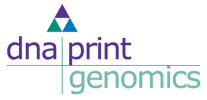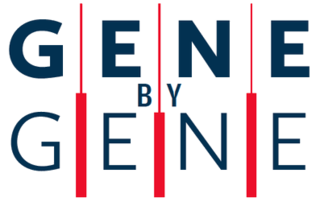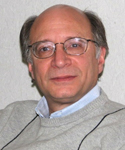
Genetic testing, also known as DNA testing, is used to identify changes in DNA sequence or chromosome structure. Genetic testing can also include measuring the results of genetic changes, such as RNA analysis as an output of gene expression, or through biochemical analysis to measure specific protein output. In a medical setting, genetic testing can be used to diagnose or rule out suspected genetic disorders, predict risks for specific conditions, or gain information that can be used to customize medical treatments based on an individual's genetic makeup. Genetic testing can also be used to determine biological relatives, such as a child's biological parentage through DNA paternity testing, or be used to broadly predict an individual's ancestry. Genetic testing of plants and animals can be used for similar reasons as in humans, to gain information used for selective breeding, or for efforts to boost genetic diversity in endangered populations.
In biology and genetic genealogy, the most recent common ancestor (MRCA), also known as the last common ancestor (LCA), of a set of organisms is the most recent individual from which all the organisms of the set are descended. The term is also used in reference to the ancestry of groups of genes (haplotypes) rather than organisms.
Genetic genealogy is the use of genealogical DNA tests, i.e., DNA profiling and DNA testing, in combination with traditional genealogical methods, to infer genetic relationships between individuals. This application of genetics came to be used by family historians in the 21st century, as DNA tests became affordable. The tests have been promoted by amateur groups, such as surname study groups or regional genealogical groups, as well as research projects such as the Genographic Project.
The Genographic Project, launched on 13 April 2005 by the National Geographic Society and IBM, was a genetic anthropological study that aimed to map historical human migrations patterns by collecting and analyzing DNA samples. The final phase of the project was Geno 2.0 Next Generation. Upon retirement of the site, 1,006,542 participants in over 140 countries had joined the project.

Spencer Wells is an American geneticist, anthropologist, author and entrepreneur. He co-hosts The Insight podcast with Razib Khan. Wells led The Genographic Project from 2005 to 2015, as an Explorer-in-Residence at the National Geographic Society, and is the founder and executive director of personal genomics nonprofit The Insitome Institute.
A genealogical DNA test is a DNA-based genetic test used in genetic genealogy that looks at specific locations of a person's genome in order to find or verify ancestral genealogical relationships, or to estimate the ethnic mixture of an individual. Since different testing companies use different ethnic reference groups and different matching algorithms, ethnicity estimates for an individual vary between tests, sometimes dramatically.
Ancestry.com LLC is an American genealogy company based in Lehi, Utah. The largest for-profit genealogy company in the world, it operates a network of genealogical, historical records, and related genetic genealogy websites.
Genetic discrimination occurs when people treat others differently because they have or are perceived to have a gene mutation(s) that causes or increases the risk of an inherited disorder. It may also refer to any and all discrimination based on the genotype of a person rather than their individual merits, including that related to race, although the latter would be more appropriately included under racial discrimination. Some legal scholars have argued for a more precise and broader definition of genetic discrimination: "Genetic discrimination should be defined as when an individual is subjected to negative treatment, not as a result of the individual's physical manifestation of disease or disability, but solely because of the individual's genetic composition." Genetic Discrimination is considered to have its foundations in genetic determinism and genetic essentialism, and is based on the concept of genism, i.e. distinctive human characteristics and capacities are determined by genes.

Myriad Genetics, Inc. is an American genetic testing and precision medicine company based in Salt Lake City, Utah, United States. Myriad employs a number of proprietary technologies that permit doctors and patients to understand the genetic basis of human disease and the role that genes play in the onset, progression and treatment of disease. This information is used to guide the development of new products that assess an individual's risk for developing disease later in life, identify a patient's likelihood of responding to a particular drug therapy, assess a patient's risk of disease progression and disease recurrence, and measure disease activity.

FamilyTreeDNA is a division of Gene by Gene, a commercial genetic testing company based in Houston, Texas. FamilyTreeDNA offers analysis of autosomal DNA, Y-DNA, and mitochondrial DNA to individuals for genealogical purpose. With a database of more than two million records, it is the most popular company worldwide for Y-DNA and mitochondrial DNA, and the fourth most popular for autosomal DNA. In Europe, it is the most common also for autosomal DNA. FamilyTreeDNA as a division of Gene by Gene were acquired by MYDNA, Inc., an Australian company, in January 2021.

23andMe Holding Co. is a publicly held personal genomics and biotechnology company based in South San Francisco, California. It is best known for providing a direct-to-consumer genetic testing service in which customers provide a saliva sample that is laboratory analysed, using single nucleotide polymorphism genotyping, to generate reports relating to the customer's ancestry and genetic predispositions to health-related topics. The company's name is derived from the 23 pairs of chromosomes in a diploid human cell.

DNAPrint Genomics was a genetics company with a wide range of products related to genetic profiling. They were the first company to introduce forensic and consumer genomics products, which were developed immediately upon the publication of the first complete draft of the human genome in the early 2000s. They researched, developed, and marketed the first ever consumer genomics product, based on "Ancestry Informative Markers" which they used to correctly identify the BioGeographical Ancestry (BGA) of a human based on a sample of their DNA. They also researched, developed and marketed the first ever forensic genomics product - DNAWITNESS - which was used to create a physical profile of donors of crime scene DNA. The company reached a peak of roughly $3M/year revenues but ceased operations in February 2009.
Personal genomics or consumer genetics is the branch of genomics concerned with the sequencing, analysis and interpretation of the genome of an individual. The genotyping stage employs different techniques, including single-nucleotide polymorphism (SNP) analysis chips, or partial or full genome sequencing. Once the genotypes are known, the individual's variations can be compared with the published literature to determine likelihood of trait expression, ancestry inference and disease risk.
In human mitochondrial genetics, Haplogroup K1a1b1a is a human mitochondrial DNA (mtDNA) haplogroup.
Genetic studies on Jews are part of the population genetics discipline and are used to analyze the chronology of Jewish migration accompanied by research in other fields, such as history, linguistics, archaeology, and paleontology. These studies investigate the origins of various Jewish ethnic divisions. In particular, they examine whether there is a common genetic heritage among them. The medical genetics of Jews are studied for population-specific diseases.
GeneTree was a family history website focused on using DNA testing to trace ancestry. A website account was free, and within their account users could order DNA tests, enter results from other testing companies, search the DNA database, create an online family tree, and correspond with family members – including sharing pictures.

Gene by Gene is a commercial genetic testing company based in Houston, Texas. The company was owned by Bennett Greenspan and Max Blankfeld, and was the parent company of Family Tree DNA. In January of 2021, Gene by Gene was acquired by US based parent company myDNA Inc. Gene by Gene and Australia company myDNA Life Private Ltd. are both subsidiaries of parent company, myDNA Inc. The current Chief Executive Officer of myDNA Inc. is, Dr Lior Rauchberger.

The International Society of Genetic Genealogy (ISOGG) is an independent non-commercial nonprofit organization of genetic genealogists run by volunteers. It was founded by a group of surname DNA project administrators in 2005 to promote DNA testing for genealogy. It advocates the use of genetics in genealogical research, provides educational resources for genealogists interested in DNA testing, and facilitates networking among genetic genealogists. As of June 2013, it comprises over 8,000 members in 70 countries. As of July 2013, regional meetings are coordinated by 20 volunteer regional coordinators located in the United States, Australia, Brazil, Canada, England, Egypt, Ireland and Russia.
Investigative genetic genealogy, or forensic genetic genealogy, is the emerging practice of utilizing genetic information from direct-to-consumer companies for identifying suspects or victims in criminal cases. As of September 2021, the use of this practice has led to the discovery of over 150 suspects of murder and sexual assault. The investigative power of genetic genealogy revolves around the use of publicly accessible genealogy databases such as GEDMatch and FamilyTreeDNA. On GEDMatch, users are able to upload their genetic data from any direct-to-consumer company in an effort to identify relatives that have tested at companies other than their own.








